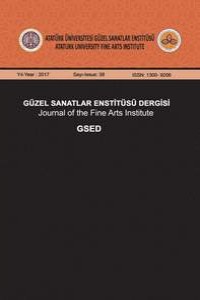Abstract
İnsanoğlu, hayatını sürdürmüş olduğu çevrenin coğrafi ve iklimsel özelliklerinin de etkisiyle, yaşamı boyunca kendine bir kültürel çevre yaratmış ve bu kültürel çevrenin belirlemiş olduğu koşullar dahilinde yaşamına ve sanatına yön vermiştir. Yaratmış olduğu bu kültürel çevre bir taraftan yaşamının temel niteliklerini belirlerken diğer taraftan da, kendisi, o kültürel çevrenin biçimlenmesini sağlamıştır. Farklı coğrafi ve iklimsel özelliklere sahip bölgeler kültürel anlamda benzerlik gösteren değerlere sahip olmuş, bu değerler de o coğrafyada yaşayan toplulukların sanatında bir şekilde yer edinmiş, bir bölgedeki herhangi bir kültürel değer benzer özellikler göstererek başka bir bölgede yeniden hayat bulmuştur. Bu durum ortak mitolojik unsurların da farklı bölgelerde tekrarlanması olarak tezahür etmiştir. İşte bu ortak değerler, sanat alanında da sıkça görülen bir durum arz etmektedir. Bu çalışmada ortak mitolojik değerlerin farklı bölgelerde yaşanan tekrarına yönelik yaklaşımlarda bulunulmuş ve bu durumun Erken Dönem Hıristiyan Resim Sanatı’nda sıkça kullanılan “Hale” biçiminin kaynağı bakımından irdelenmesi yapılmıştır. Aynı zamanda benzer özellikler gösteren farklı bölgelere ait mitolojik unsurların bu biçimin oluşmasına katkısının olup olmadığı ortaya konulmaya çalışılmıştır. Elde edilen veriler ışığında sanatsal anlamda farklı dönem ve topluluklar tarafından tekrarlanan hale motifinin benzerlik gösterdiği ve bunun da kültürel ve sanatsal etkileşim bağlamında önem taşıdığı düşünülmektedir.
Abstract
The human kind, with the help of the geographical and climatic characteristics of the environment it has lived in, created cultural environment for itself and led a life and practice of art by the condition of this cultural environment throughout its history. On one hand, this cultural environment it has created has determined the basic qualities of life, while on the other hand, humanity has shaped that cultural environment. Regions with different geographical and climatic characteristics has gained culturally similar values, and these values took part in the art of communities living in those geographies in some way, while a cultural value in a region reemerged in other parts of the world with similar characteristics. This situation has continued in the form of repetition of common cultural, as well as mythological, elements in different regions. Thus, these common values present a frequently seen situation in art, too. In this study, approaches regarding the repetition of common mythological values in different regions were discussed and this issue was investigated in terms of the origins of the “Nimbus” shape, which was frequently used in the Early Period Christian Art of Painting. It was also aimed to reveal whether or not both cultural and mythological elements of different regions with similar characteristics contributed to the formation of this shape. In the light of the data obtained, it was concluded that the nimbus motifs repeatedly used for art in different periods and communities showed similarities, and this has significance in terms of cultural and artistic interaction.
References
- ERKAL, Mehmet (2000). Semboller ve Yorumları, Zafer Matbaası, İstanbul.
Abstract
The human kind, with the help of the geographical and climatic characteristics of the environment it has lived in, created cultural environment for itself and led a life and practice of art by the condition of this cultural environment throughout its history. On one hand, this cultural environment it has created has determined the basic qualities of life, while on the other hand, humanity has shaped that cultural environment. Regions with different geographical and climatic characteristics has gained culturally similar values, and these values took part in the art of communities living in those geographies in some way, while a cultural value in a region reemerged in other parts of the world with similar characteristics. This situation has continued in the form of repetition of common cultural, as well as mythological, elements in different regions. Thus, these common values present a frequently seen situation in art, too. In this study, approaches regarding the repetition of common mythological values in different regions were discussed and this issue was investigated in terms of the origins of the “Nimbus” shape, which was frequently used in the Early Period Christian Art of Painting. It was also aimed to reveal whether or not both cultural and mythological elements of different regions with similar characteristics contributed to the formation of this shape. In the light of the data obtained, it was concluded that the nimbus motifs repeatedly used for art in different periods and communities showed similarities, and this has significance in terms of cultural and artistic interaction.
References
- ERKAL, Mehmet (2000). Semboller ve Yorumları, Zafer Matbaası, İstanbul.
Details
| Journal Section | Articles |
|---|---|
| Authors | |
| Publication Date | May 29, 2017 |
| Submission Date | January 18, 2017 |
| Published in Issue | Year 2017 Issue: 38 |
Obtaining permissions for studies requiring ethics committee approval regarding the implementation of ethical rules and including information about permission in the article was added to the criteria. In this direction, Ethics Committee Permission is required for articles submitted to our journal and meeting the conditions stated below.
• Any research conducted with qualitative or quantitative approaches that require data collection from participants using questionnaires, interviews, focus group work, observation, experimentation, and interview techniques.
Also;
• Obtaining and indicating permission from the owners for the use of scales, surveys and photographs belonging to others,
• It should be stated that the copyright regulations are complied with for the intellectual and artistic works used.


